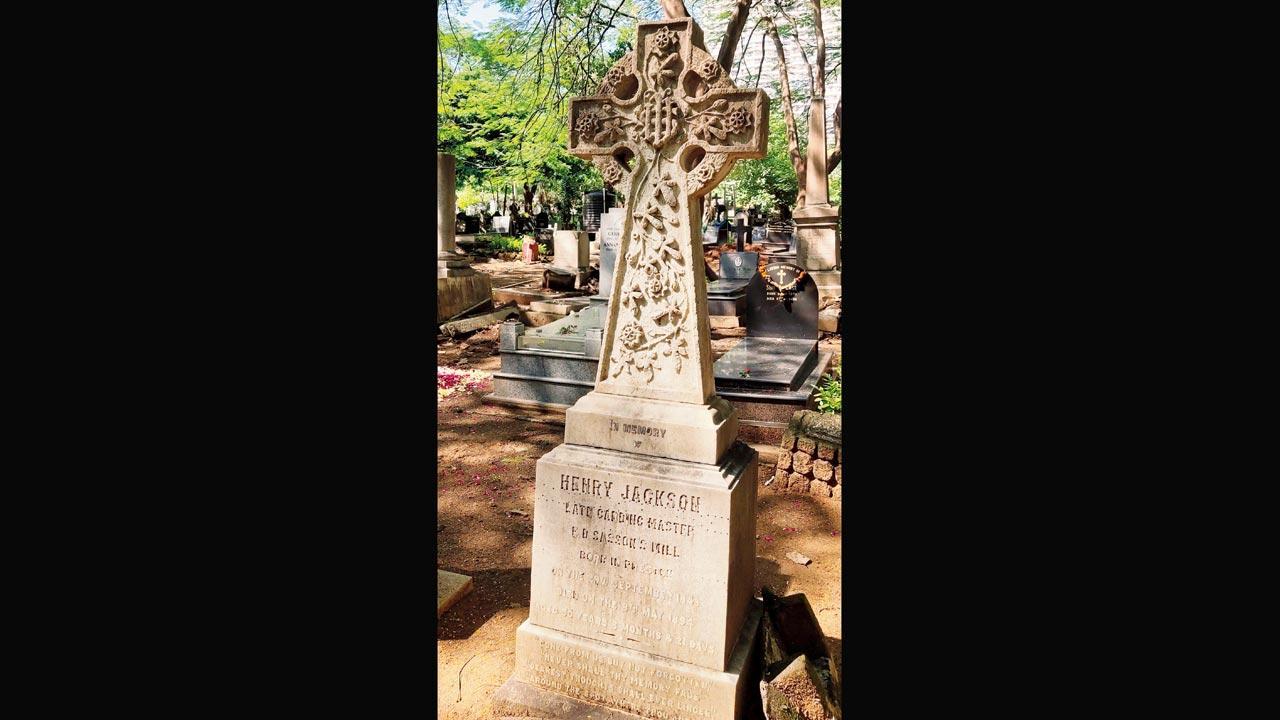Apart from a crash course in the city’s history, a walk inside Sewri Christian Cemetery offers a fascinating visual spectacle, as it throws light on the now-forgotten art form — tombstone design. Sadly, like so many other priceless elements of old Bombay, this, too, has been phased out

One of the exquisitely carved tombstones at the Sewri cemetery
 It's been exactly two years since this columnist had the pleasure of conducting a walk for a bunch of enthusiastic mid-day readers inside the Sewri Christian Cemetery. During the early stages of planning that walk, some asked — Why a burial ground? And, on a lighter note, friends chuckled that my moonlighting stint as a grave fact-checker would finally come out in the open! Far from such dark pursuits, the many recces — all in broad daylight — for my research, made it increasingly clear that apart from the unbelievable volumes of history buried [pun intended] in one space, the cemetery was also an open-air exhibition of finely carved tombstones, memorials and epitaphs.
It's been exactly two years since this columnist had the pleasure of conducting a walk for a bunch of enthusiastic mid-day readers inside the Sewri Christian Cemetery. During the early stages of planning that walk, some asked — Why a burial ground? And, on a lighter note, friends chuckled that my moonlighting stint as a grave fact-checker would finally come out in the open! Far from such dark pursuits, the many recces — all in broad daylight — for my research, made it increasingly clear that apart from the unbelievable volumes of history buried [pun intended] in one space, the cemetery was also an open-air exhibition of finely carved tombstones, memorials and epitaphs.
ADVERTISEMENT
Some of the city’s famous visionaries, brilliant minds and creative geniuses, both Indian and foreign, as well as countless unknown folk have their lives beautifully encapsulated thanks to the art and detailing on their graves. It was a fine example of the term ‘history being etched in stone.’
As I dug deeper [sorry, the puns continue] and tread further into this massive site that is over 150 years old, with over 20,000 graves, the stories of the buried reveal intriguing stories. Take for example the tombstone of Scotsman James Taylor. He was the former sheriff of Bombay and secretary of the Royal Asiatic Society. A miniature roundel of what we believe is a representation of his face, with a list of his achievements allowed us to put a face to the man whose marriage proposal to English author Charlotte Bronte was rejected because she was not keen on travelling to India [note that the rejection is not mentioned on the epitaph].
There were tragic stories, too; like that of 26-year-old P&O officer Edward Mansfield whose tombstone reads — “he lost his life from the bursting of his balloon,” or that of John Walsh, 3rd Engineer who died on another ship during the massive explosion at Fort SS Stikine at Victoria Dock in 1944. Such information and timelines would have gone unnoticed had these facts not been mentioned on their tombstones. I must add here that though many graves were found in semi-decrepit shape, battered from years of heat, rain, wind and neglect, the sculpture and carving across these reminders of history made us all believe that we were in some sort of semi-fantastical universe; a sharp contrast from the concrete castles that lorded over us from beyond the boundary walls.
Cherubs, angels and archangels, Christ carrying the crucifix, Mother Mary, floral art, Gaelic and Scottish symbols…the elements on display drew a lot of intrigue and awe among the participants on that walk. From managers of cotton mills to inspectors of the Bombay Police, special drainage engineers in the city’s Municipality and chief justices, we also got a small idea about some long-gone professions and institutions in the city.
As we moved to the graves that were built in post Independence India, we noticed a gradual yet obvious shift in design. What caused the decline of this art form, we will never know, but a visit to another cemetery in the city, a relatively newer site, on All Soul’s Day only confirmed this observation. New graves are devoid of these gorgeously carved tombstones and appear more uniform and assembly-like. Most are of a set prototype – black (majority) or white marble with the odd verse from The Bible, apart from the dates of birth and death. An addition in some cases is a photo image of the deceased that is pasted on the marble. Far from the tasteful aesthetics of roundels and cut-stone work, this is a sign of the times we live in. Undertakers oversee Christian burials around a funeral from start to end. A one-size-fits-all business model has emerged, and seems to be here to stay.
Sewri Cemetery’s personalised memorials have stood the test of time, thanks to those unsung creators, who have thus offered coming generations and researchers a peek into the lives of residents and travellers to the city that span the 19th, 20th and 21st centuries; it is a gift that no Google search will ever be able to offer, now, or even a century later. These skilled craftsmen deserve their place under the sun, alongside the men and women whose tombstones they designed, and that remain as a silent testimony of their art.
mid-day’s Features Editor Fiona Fernandez relishes the city’s sights, sounds, smells and stones...wherever the ink and the inclination takes her. She tweets @bombayana
Send your feedback to mailbag@mid-day.com
 Subscribe today by clicking the link and stay updated with the latest news!" Click here!
Subscribe today by clicking the link and stay updated with the latest news!" Click here!







